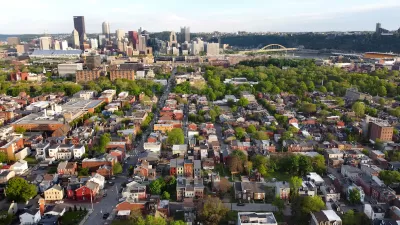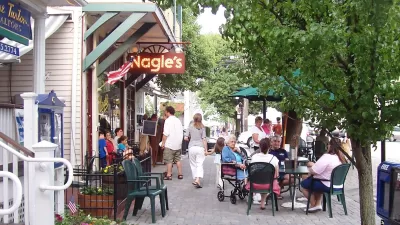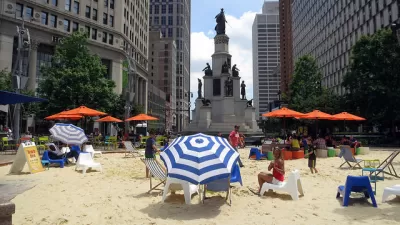Since 2004, the Next Generation of New Urbanists (NextGen) has welcomed new ideas and new faces into the Congress for the New Urbanism.
Since 2004, the Next Generation of New Urbanists (NextGen) has welcomed new ideas and new faces into the Congress for the New Urbanism. Comprised of a core group of leaders, generally between ages 25 and 40, the NextGen focuses on pushing the principles of new urbanism, as defined in the Charter, forward.
Beyond providing a barrier-free entrée point to the CNU, the loose organization's main thrust is to recognize that the impressive accomplishments of the 30-year old new urbanist movement has created a false sense that the challenges CNU initially sought to conquer have, well, been conquered. To be sure hundreds of projects, an expansive body of unified research, and dozens of related organizations continue to solidify a planning reform movement that dates to the beginning of the American municipal planning profession.
Today, the wide acceptance of peak oil, global warming, and the recent economic crisis-issues new urbanism tackle head on-provides an added boost, if not a sense of urgency.
But while progressive planning efforts continue to revive a normative trajectory of city building- one found before the meteoric rise of petroleum-based planning-it's increasingly obvious that translating great principles, design manuals, built projects, and innovative zoning codes into truly great places is still not done easily.
With this in mind, 17 core NextGen leaders convened in New Orleans' Marigny/Bywater neighborhood this past November to discuss the future of urbanism and the role CNU should play in continuing the project of town and city making.
As attendees began to trickle into the Big Easy, the diversity of the movement quickly became apparent: the CNU's founding members are primarily architects from the babyboom generation, while the NextGen's leadership-and the Congress as a whole-is now comprised of zoning attorneys, planners, business strategists, marketing experts, engineers, landscape architects, urban designers, developers, students, and yes, plenty of architects. This professional diversity differentiates the movement from other planning or building organizations, and is a testament to CNU's unique, interdisciplinary approach.
The weekend of intense, intelligent discussion began with each attendee presenting a 20-slide, 6:40 Pecha Kucha presentation. While each presenter laced the wall of the Bywater house in which we crammed with new ideas, criticism, and goals, not one topic was repeated. Yet, the common thread of improving the efficacy of the CNU, and the general livability of our cities, was found throughout.
After the presentations, everyone broke into smaller working groups to push a number of initiatives forward. Central among these is translating each Charter principle into the first person, i.e, putting the onus back on individual to take personal responsibility in creating sustainable buildings, streets, neighborhoods, districts, corridors, towns, cities, and regions. Other initiatives include improving the annual Congress experience, improving communication to those outside of the CNU movement, expanding our research initiatives, and continuing the transitioning of the the organization's founders, who are now reaching their '60s.
All set to the backdrop of New Orleans' joi de vivre, it was a pretty good weekend.
Fast-forward to today, the NextGen has been busy pushing each of the identified initiatives forward. Central to the effort is a new strategic plan guiding the ongoing development of the NextGen and the continued evolution of the new urbanism. To this end, two products supporting this effort are now available.
The first is the beta version of an open source project, called Tactical Urbanism: Short TermAction || Long Term Change. Authored by yours truly, with Dan Bartman, Ronald Woudstra, and Aurash Khawarzad, the report covers a variety of initiatives utilizing a less formal, but dynamic approach to improving our neighborhoods and cities.
And in further support of CNU 19, which is happening in Madison, Wisconsin this year, NextGen has organized AuthentiCity, a design competition targeting an infill site. Please have a look at the competition page, and spread it around to those who may be interested in submitting an entry.
While the new urbanism is not so new anymore, it is still full of talented, passionate, and driven people committed to the movement's principles. For those who attended the Bywater/Marigny retreat, the new urbanism is now morphing into the Next Urbanism, which will continue to build from the extraordinary effort led by those who came before us.
If interested, please join the discussion in Madison. We have a lot of work to do.

Pennsylvania Mall Conversion Bill Passes House
If passed, the bill would promote the adaptive reuse of defunct commercial buildings.

Coming Soon to Ohio: The Largest Agrivoltaic Farm in the US
The ambitious 6,000-acre project will combine an 800-watt solar farm with crop and livestock production.

World's Largest Wildlife Overpass In the Works in Los Angeles County
Caltrans will soon close half of the 101 Freeway in order to continue construction of the Wallis Annenberg Wildlife Crossing near Agoura Hills in Los Angeles County.

California Grid Runs on 100% Renewable Energy for Over 9 Hours
The state’s energy grid was entirely powered by clean energy for some portion of the day on 37 out of the last 45 days.

New Forecasting Tool Aims to Reduce Heat-Related Deaths
Two federal agencies launched a new, easy-to-use, color-coded heat warning system that combines meteorological and medical risk factors.

AI Traffic Management Comes to Dallas-Fort Worth
Several Texas cities are using an AI-powered platform called NoTraffic to help manage traffic signals to increase safety and improve traffic flow.
City of Costa Mesa
Licking County
Barrett Planning Group LLC
HUD's Office of Policy Development and Research
Mpact Transit + Community
HUD's Office of Policy Development and Research
Tufts University, Department of Urban and Environmental Policy & Planning
City of Universal City TX
ULI Northwest Arkansas
Write for Planetizen
Urban Design for Planners 1: Software Tools
This six-course series explores essential urban design concepts using open source software and equips planners with the tools they need to participate fully in the urban design process.
Planning for Universal Design
Learn the tools for implementing Universal Design in planning regulations.



























